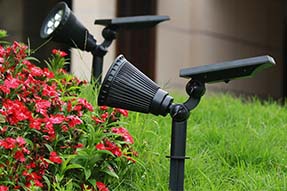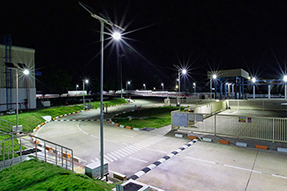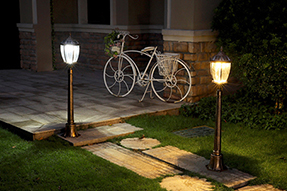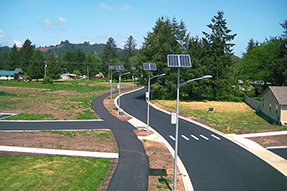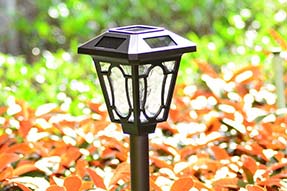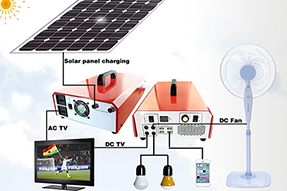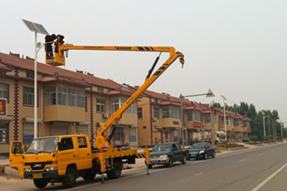Do you know how to design a solar lawn light ?
Solar lawn light is rapidly developing in current market, a lot of people would like to know how to design so amazing solar product. Now let me present you the miracle product as below:
1. Brief Introduction.
As a new burgeoning cleaning energy, solar energy has been rapidly promoted and applied because of its irreplaceable advantages. As the fourth generation new lighting source, it has been effectively applied for cities decoration and beauty, roadway illumination, indoor lighting and other field brightness. Especially for remote area where has no public grid, solar lighting has a widely application prospect. Usually, most of people think it is great pioneering that energy-saving lamp can save the four-fifths of power, while LED is more energy-saving than a quarter of energy-saving lamp, which is great renovation for solid lighting source.
Moreover, LED has the advantages including high lighting quality, nearly no radiation and low cost for maintenance, etc, which belongs to typical cleaning illumination lighting source. The successful research of super brightness LED has numerously reduce the utilization cost of solar lamp, making it reach or approach the initial installation cost of power frequency alternating current lighting system, and it is environmental protection, easy to install, economy and energy-saving. LED has been more and more applied for lighting fields because of its high quality lighting effectiveness, low heat, etc, which presents the tendency to replace traditional illumination lighting source.
In the West of China, solar street light and solar garden light are approaching scale for non-main road. With the great development of solar lighting, “cleaning illumination” would become a tendency. LED lawn light is as one of presentations, it would be greatly promoted and applied.
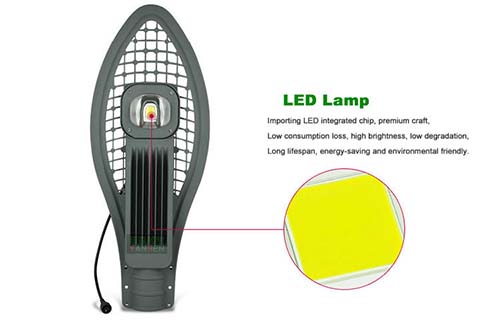
2. The Definition and Structure Component of LED Solar Lawn Light.
Solar lawn light is to exploit the energy of solar cells for working, it converts solar power into electric power and stores into battery when solar cells is radiated by sunlight in daytime, the battery provide power supply for LED of solar lawn light in night. Its feature is safety, energy-saving, convenient and environmental friendly. It is applied for decorating residential lawn and public garden. The components of LED solar lawn light include solar panel, super brightness LED lamp, rechargeable battery with maintenance free and lamp body, etc.
3. The System Composition and Control System of Solar Lawn Light.
1) The System Composition of Solar Lawn Light.
LED solar lawn light is an independent power generation system. It can independently complete to convert solar power into electric power, and convert electric power into thermal power for decoration and illumination, no need pave complicated cables. An independent solar pv system is made up of solar panel, controller, inverter, measurement meter and computer monitoring and battery or other assistant power generation devices. The characteristics of solar pv system include non-rotatable components, no noise, no air pollution, no air emission pollution, no need fuel, low cost for maintenance, reliable and stable operation, solar panel is as the core component, its lifespan is above 25 years, the scale of solar power generation can be easily expanded according to requirement.
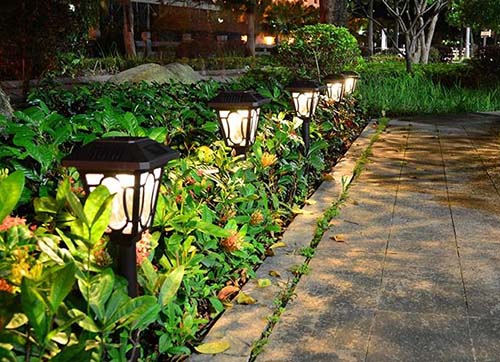
Below picture is a typical solar pv system which provides supply Direct Current. Solar pv array consists of solar cells being series and parallel connected according to system requirement, it can convert solar into electricity under being radiated by sunlight, it is the core component of solar pv system.
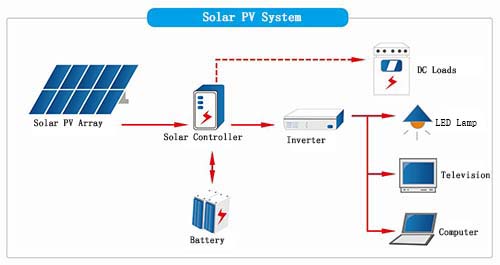
LED lawn light is a small solar power generation system (below picture), it is made up of solar cells, controller, battery, LED lamp and lamp-post.
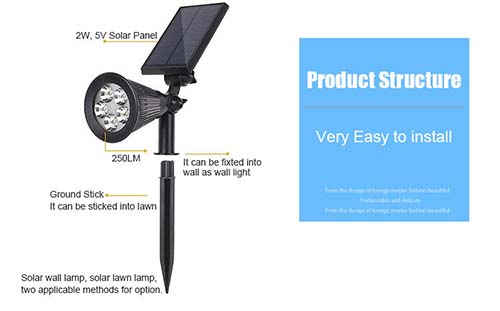
2) The Control Principle of Solar Lawn Light.
The controller of solar lawn light is mainly used for battery charging and discharging controllable. Below is a diagram for the basic control system. This diagram is a basic solar pv application system, it is made up of solar panel, battery, solar controller and loads. K1 and K3 are switch power for charging, K2 is switch power for discharging, they are inside solar control center. The on or off of switch is decided by control circuit depending on system charging and discharging situation. K1 and K3 is cut-off when battery is full charged, K1 and K3 is closed when battery need be charged. K2 is closed when battery need discharge for loads.
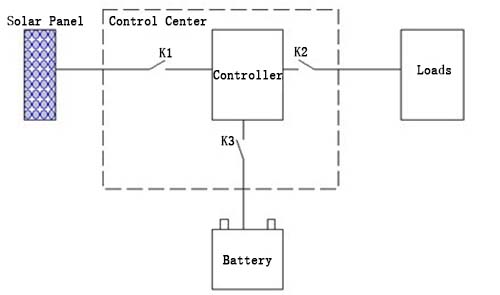
Usually, a quality solar controller should have below protection function:
(1). Direct-Charge Protection Point Voltage.
Direct-charge is also said as boost charge, usually, it is to use high current and high voltage to charge battery when the battery voltage is too low, but it has a control point, also said as protection point, it should shop to direct-charge when the terminal voltage of battery is higher than this protection point. Direct-charge protection point voltage is also said as “over-charge protection point” voltage, the battery voltage can’t exceed this protection point when charging, otherwise it would over-charge, which would damage the battery.
(2). Equalization Charge Control Point Voltage.
Usually, battery would be in static state some times after direct-charge finishing, its voltage would drop, it would enter into equalization state when its voltage drops to “recovery voltage” value. Why the equalization charge need be set ? Because someone batteries would fall behind (its terminal voltage is relative lower) after direct-charge finishing, in order to pull back this some units, to make all of battery terminal voltage be uniform, so need have high voltage with moderate current to charge a little time. The time of equalization charge don’t need too long, usually it is about some minutes ~ some more than ten minutes, it is bad for battery if to set more long time. For small solar system with one or two units battery, equalization charge don’t have many effectiveness, so, controller of solar street light don’t set equalization charge.
(3). Floating-Charge Control Point Voltage.
Usually, battery would be in static state some times after equalization charge finishing, to make its terminal voltage auto to drop, it would enter into Floating-Charge state after dropping to “maintenance voltage”, presently it is to adopt PWM method, which is like “purling charge” (small current to charge), it would auto to charge a little when battery voltage is too low, it can avoid the temperature of battery to continue increase, which is good for battery, because internal temperature of battery has big influence to battery charge and discharge. In fact, the method of PWM is to stabilize the terminal voltage of battery, the battery charging current can be reduced by adjusting pulse width. This is very technical charging management system. Specifically it is in the later period of charging, when the residual current capacity of battery is over 80%, it must reduce charging current, to avoid over-charge.
(4).Cut-off Over-Discharge Voltage Protection.
The discharge of battery can’t less than this value, this is National Standard. Although battery manufacturers have their own standard, the final standard should be closing to National standard. In order to safety, usually, the over-discharge voltage protection point of 12V battery would add 0.3V as temperature compensation or adjustment for control circuit, then the over-discharge protection voltage of 12V battery is 11.10V, the over-discharge protection voltage of 24V system is 22.20V. Presently, most of manufacturers are to adopt 22.2V (for 24V system) standard.
3) Design for The Charge and Discharge Controller of Solar Lawn Light.
Charging controller serves as the connector circuit of solar cells and battery, usually, it is expected to work at the maximum power point, to realize more high efficiency, but the charging control of battery should be considered when realizing the Maximum Power Point Tracing (MPPT). Presently, the main circuit topology is buck-mode circuit convertor, booster circuit convertor and Cukor circuit convertor etc. The output voltage of solar cells has a high fluctuation, but Buck-Mode convertor or Booster convertor just can reduce voltage or boost voltage, so, solar cells can’t completely work at the Maximum Power point in a large-scale, then to cause the system efficiency decrease. At the same time, the input current ripple of Booster convertor is relative high, the system would work under interrupted state if don’t add a energy-storage capacitor, then to make the output current of solar cells be intermittence, don’t work at the optimal working state. While the output current ripple of Booster convertor is high, it is not good for battery lifespan if use this current to charge battery. Cukor convertor has boost-voltage and reduce-voltage function, it can realize the maximum power point tracing (MPPT) in a large-scale if to use Cukor convertor for charging controller of pv system, which is good for system efficiency improvement. Therefore, Cukor convertor is always applied for the main circuit of charging controller, its topologic diagram is as below:
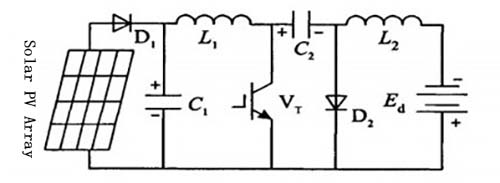
When Cukor convertor is under continuous loads current, its circuit stable process includes below:
(1) Switch Vr is conductively connection.
In this period of Vr conduction, the voltage of capacitor C2 makes Diode D2 cut-off, at this time, input current iL2 makes L1 store power. The discharging current iL2 of C2 makes L2 store power, and power supply for loads, as below left diagram (a).
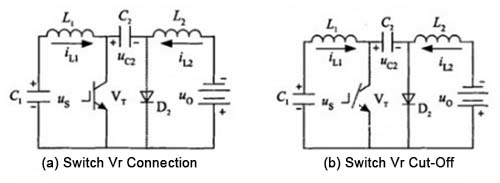
(2) Switch Vr is Cutting-Off.
In this period Vr is cutting-off, Diode D2 is conductive connection, the discharge current iL2 of power and L1 charge C2, at the same time, the discharge current iL2 of L2 sustain loads, as diagram (b).
Therefore, C2 is charged during Vr cutting-off, C2 discharge for loads during Vr being conductive connection, the function of C2 is to transmit power.
According to above introduction, I think that you have learnt what is solar lawn light and know how to approximately design it. Above is just basic knowledge for you to make the first step to design the solar light, if you actually would like to design one, it is necessary for you to learn more about the knowledge, such as the working principle of its electric circuit, how to choose optimal lighting source for the light system, etc.
Bingsolar Power, 5th, April, 2018
